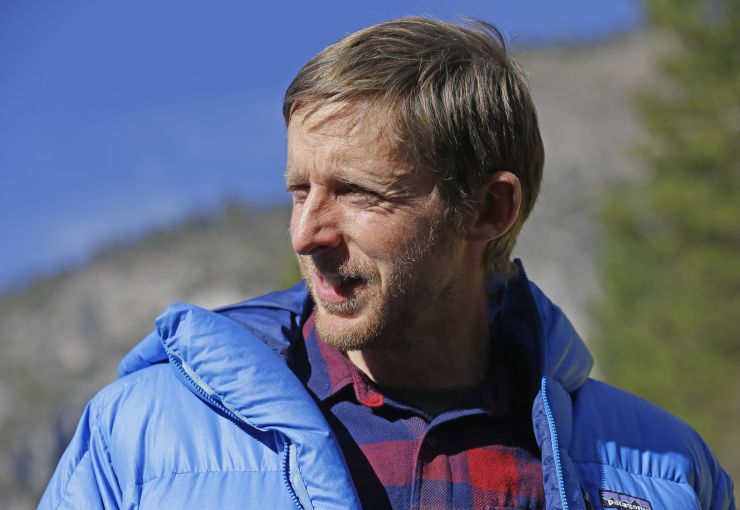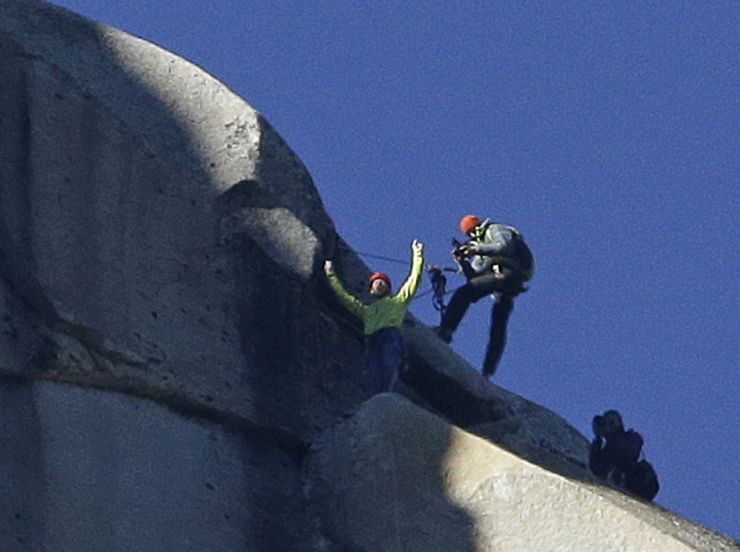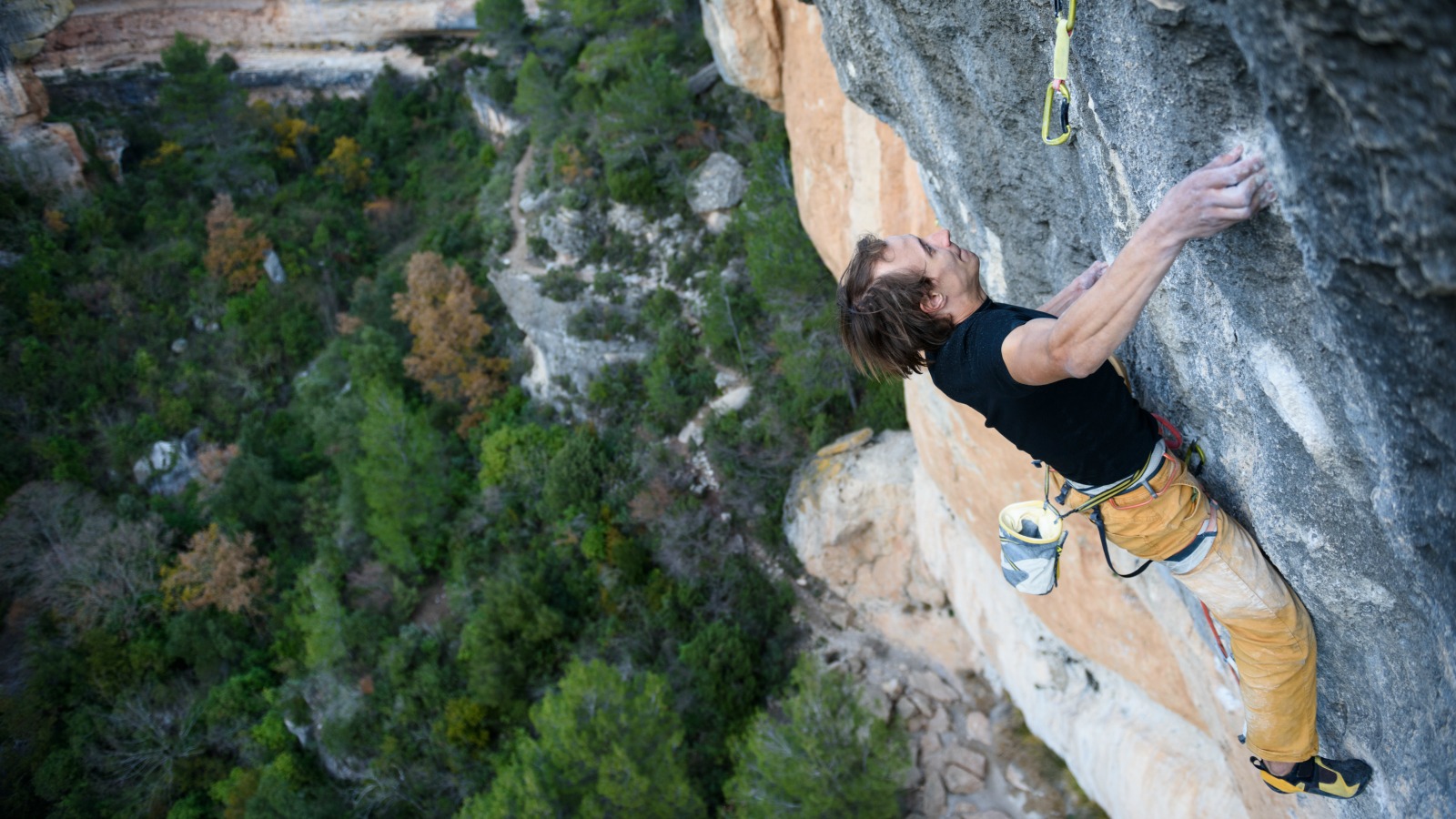This story was originally published by Fusion and is reproduced here as part of the Climate Desk collaboration.
Professional rock climber Tommy Caldwell admits he feels more comfortable climbing sheer cliff faces thousands of feet in the air than discussing public policy with national lawmakers.
“Climbing big walls is what I know,” says the 38-year-old climber, who made national headlines for bagging the first free ascent of Yosemite’s Dawn Wall in 2015. “Getting dressed up in a suit and going up to Capitol Hill is definitely not my safe spot.”
Nevertheless, Caldwell, along with a number of the world’s top climbers like Alex Honnold, Kai Lightner, Sasha DiGiulian, and Libby Sauter, joined advocacy groups and outdoor industry representatives in Washington, D.C., last Thursday to lobby for the protection of our nation’s public lands.
“I’ve spent my entire life on public lands. More than 50 percent of the days of my life have been spent in national parks,” Caldwell says. “I think public lands may be the best thing about America, and I don’t want that going away.”
Organized by the American Alpine Club and the Access Fund, the event dubbed “Climb the Hill” featured a group of over 40 climbers, advocates, and industry representatives from across the country. Divided into teams representing geographic regions, the climbers visited the offices of over 50 different congressional members and officials, sharing stories of their experiences on public lands and voicing opposition to the Trump administration’s moves to defund public lands agencies, expand fossil fuel developments, and rescind national monuments designated under the Antiquities Act.
“One of the goals was to provide a unique voice so that congressional representatives could understand a different perspective on public lands,” says Erik Murdock, policy director at the Access Fund, one of the advocacy groups behind the event. “About 60 percent of our climbing areas across the country are on federal lands. Our mission is to make sure that these areas are protected and conserved for future generations.”
Of particular concern to the coalition of climbers is Utah’s Bears Ears National Monument — one of the 24 monuments currently threatened by President Trump’s recent executive order, which calls on Secretary of the Interior Ryan Zinke to evaluate national monuments over 100,000 acres in size and created since 1996.
Designated a national monument by Obama last year, Bears Ears has been the center of a longstanding land dispute that pits Native American groups and outdoor recreation advocates against landowners and state officials who oppose federal land control and want to keep the area open for drilling, mining, logging, and heavy recreation, such as with ATVs.
Secretary Zinke, who has also been tasked with reexamining drilling laws in national parks, was in Utah last week to review Bears Ears and Grand Staircase-Escalante National Monument — just two of the 24 parks that could potentially be rescinded or scaled down under the president’s order.
No president has ever rescinded or altered a National Monument since the Antiquities Act was founded in 1906, and many legal scholars believe the move would not hold up in court.
The interior secretary is expected to submit a recommendation to President Trump by the beginning of June, and public commentary for Bears Ears will close May 26th. You can still weigh in to protect Bears Ears by writing to Secretary Zinke here.

Climber Tommy Caldwell speaks during a news conference in El Capitan meadow in Yosemite National Park, California, in 2015. AP
For climbers, the 1.35 million acres of dramatic desert land protected under the Bears Ears National Monument is home to over a hundred historic climbing spots like Indian Creek and Valley of the Gods, not to mention the potential for many areas yet to be discovered.
“Bears Ears is one of the most unique climbing areas in the country, as well as being historically significant,” says Caldwell, who has been visiting the area since he was 4 years old. “The fact that that could be taken away is kind of scary in a lot of ways. Who knows once that one’s gone, what else is going to be on the chopping block?”
What has the nine-fingered mountain man frightened should probably frighten us all. With the future of public lands so uncertain, there are millions of Americans — not just climbers, but hikers, bikers, skiers, paddlers, campers, fishers, and hunters — who are beginning to get involved in the struggle to preserve these places that are critical to their personal pursuits.
“People are really fired up right now about wanting to keep public lands public,” says Aaron Clark, a conservation manager for the International Mountain Bicycling Association. “We’ve seen a substantial uptick in involvement on the advocacy front.”
According to Clark, the administration’s moves to go after national monuments also has the mountain biking community organizing, and the IMBA is focusing their advocacy efforts on protecting popular biking areas like San Gabriel National Monument outside of L.A. and Berryessa Snow Mountain National Monument in Northern California. “Climbing or mountain biking may not disappear if the monument designation disappears,” Clark says. “But if the landscape changes to diminish the experience or natural beauty, then that access just gets diminished.”

Tommy Caldwell raises his arms after reaching the summit of El Capitan in 2015, as seen from the valley floor in Yosemite National Park, California. AP
Different interest groups can sometimes clash over how public lands should best be used. For example, many ATV and dirt bike enthusiasts have come out in support of Trump’s review of national monuments, which can sometimes restrict outdoor motorized activities, and in other instances hikers and mountain bikers have butted heads over who has the right to trails.
But when unified, the outdoors community can become a power powerful political force — as was the case when Utah Rep. Jason Chaffetz introduced a bill in the House that would have sold of 3.3 million acres of federal land. He rescinded the bill a week later after receiving an overwhelming backlash from hunters, fishermen, and other outdoors enthusiasts who saw the move as a threat to their recreational activities.
“Attacks on public lands in recent years have galvanized the outdoor community to wake up to the fact that environmental protections and conservation is not a done deal, that there is still a lot of work to be done,” says Tania Lown-Hecht, communications director for the Outdoor Alliance. Still, she sees a, “largely untapped potential in the millions of people who love to get outside.”
Advocates like Lown-Hecht are also quick to point out that the sheer number of people playing outdoors translates into serious economic gains. According to one study, the outdoor recreation industry creates 7.6 million jobs and is estimated to generate $887 billion dollars a year in consumer spending.
These numbers are beginning to catch the attention of lawmakers on both sides of the aisle. Last year, the Outdoor Recreation Jobs and Economic Impact Act of 2016 — calling for an economic assessment of the outdoor industry — was signed into law by Obama after sailing through both the House and the Senate with bipartisan support.
Results of that study may not be seen until 2020, but in the meantime, industry leaders like Patagonia and Arc’teryx have taken more proactive measures to make their economic weight known. In protest to Utah Gov. Gary Herbert’s support of a resolution urging President Trump to rescind the Bears Ears National Monument, both companies announced in February that they would boycott the Outdoor Retailer Show, a major trade show held annually in Salt Lake City that brings about $45 million dollars to the state.
“The outdoor industry creates three times the amount of jobs as the fossil fuel industry, yet the governor has spent most of his time in office trying to rip taxpayer-owned lands out from under us and hand them over to drilling and mining companies,” Patagonia founder Yvon Chouinard wrote in an op-ed. “We love Utah, but Patagonia’s choice to return for future shows will depend on the governor’s actions.”
As more and more members of the outdoor community find their political voices, the future of Bears Ears will be a key test to see if the rock climbing community can make theirs heard.
Caldwell, who confesses to being “unbelievably, un-politically engaged” for most of his life, says that now is the time for everyone to speak up. “I understand so many people think that Capitol Hill is so far outside their world it doesn’t make a difference,” he says. “I learned that writing letters, making calls to your senators, getting involved, this stuff actually makes a huge difference. It works. Everyone has a voice.”




